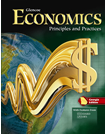Economics Principles and Practices © 2012 GeorgiaChapter 16:
International TradeChapter Overviews Section 1: Absolute and Comparative Advantage
Trade allows nations to specialize in some products and then trade them for goods and services that are more expensive to produce. If people and countries specialize in the things they do relatively more efficiently, and if they engage in trade to secure the things they do not produce or do not own, then total world output will increase and everyone will be better off. Section 2: Barriers to International Trade
Trade barriers, such as tariffs and quotas, are used to restrict the free flow of products between nations. Trade barriers are supported for a number of reasons, but the costs of such actions almost always outweigh the benefits. Trade barriers made the Great Depression in the early 1930s even worse, but the world has moved toward freer trade since 1934. Nations have made considerable progress under the GATT, which evolved into the World Trade Organization. The North American Free Trade Agreement (NAFTA) will eventually remove most of the trade barriers in North America. Section 3: Foreign Exchange and Trade Deficits
The current system of flexible exchange rates means that the value of a country's currency fluctuates with the supply and demand for it. The strength of a nation's currency often determines the amount of goods and services that are exchanged in trade. For example, in 1985 and 2002, the strong dollar led to large trade deficits. When the value of the dollar declined, the trade deficit improved. Because deficits tend to be self-correcting, most nations no longer design economic policies just to improve the balance of payments.  | 






